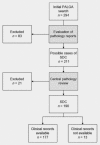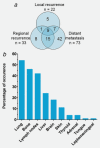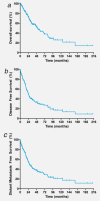A clinicopathological study and prognostic factor analysis of 177 salivary duct carcinoma patients from The Netherlands
- PMID: 29492965
- PMCID: PMC6055864
- DOI: 10.1002/ijc.31353
A clinicopathological study and prognostic factor analysis of 177 salivary duct carcinoma patients from The Netherlands
Abstract
Salivary duct carcinoma (SDC) is a subtype of salivary gland cancer with a dismal prognosis and a need for better prognostication and novel treatments. The aim of this national cohort study was to investigate clinical outcome, prognostic factors, androgen receptor (AR) and human epidermal growth factor receptor 2 (HER2) expression. SDC patients diagnosed between 1990 and 2014 were identified by the Nationwide Network and Registry of Histo- and Cytopathology in the Netherlands (PALGA). Subsequently, medical records were evaluated and pathological diagnoses reviewed. Data were analyzed for overall survival (OS), disease-free survival (DFS), distant metastasis-free survival (DMFS) and prognostic factors. AR was evaluated by immunohistochemistry (IHC), HER2 by IHC and fluorescent in-situ hybridization. A total of 177 patients were included. The median age was 65 years, 75% were male. At diagnosis, 68% presented with lymph node metastases and 6% with distant metastases. Median OS, DFS and DMFS were 51, 23 and 26 months, respectively. In patients presenting without distant metastases, the absolute number of positive lymph nodes was associated with poor OS and DMFS in a multivariable analysis. AR and HER2 were positive in 161/168 (96%) and 44/153 (29%) tumors, respectively, and were not prognostic factors. SDC has a dismal prognosis with primary lymph node involvement in the majority of patients. The absolute number of lymph node metastases was found to be the only prognostic factor for DMFS and OS. AR expression and-to a lesser extent-HER2 expression hold promise for systemic treatment in the metastatic and eventually adjuvant setting.
Keywords: ErbB-2; androgen receptors; fluorescence; immunohistochemistry; in situ hybridization; prognosis; receptor; salivary duct carcinoma; salivary gland neoplasms; survival.
© 2018 The Authors International Journal of Cancer published by John Wiley & Sons Ltd on behalf of UICC.
Figures




References
-
- Kleinsasser O, Klein HJ, Hubner G. Salivary duct carcinoma. A group of salivary gland tumors analogous to mammary duct carcinoma. Arch Klin Exp Ohren Nasen Kehlkopfheilkd 1968;192:100–5. - PubMed
-
- Seifert G, Brocheriou C, Cardesa A, et al. WHO International Histological Classification of Tumours. Tentative histological classification of salivary gland tumours. Pathol Res Pract 1990;186:555–81. - PubMed
-
- Nardi V, Sadow PM, Juric D, et al. Detection of novel actionable genetic changes in salivary duct carcinoma helps direct patient treatment. Clin Cancer Res 2013;19:480–90. - PubMed
-
- Jaspers HC, Verbist BM, Schoffelen R, et al. Androgen receptor‐positive salivary duct carcinoma: a disease entity with promising new treatment options. J Clin Oncol 2011;29:e473–6. - PubMed
MeSH terms
Substances
LinkOut - more resources
Full Text Sources
Other Literature Sources
Medical
Research Materials
Miscellaneous

